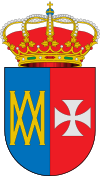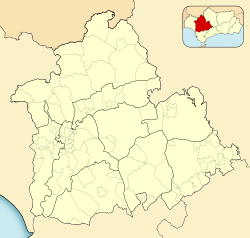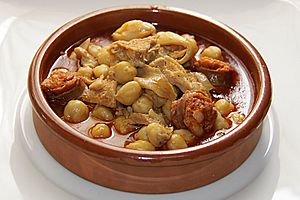El Viso del Alcor facts for kids
Quick facts for kids
El Viso del Alcor
|
|||
|---|---|---|---|
|
city
|
|||

Church of Santa María del Alcor
|
|||
|
|||
| Country | |||
| Autonomous community | |||
| Province | Seville | ||
| Comarca | Los Alcores | ||
| Area | |||
| • Total | 20.40 km2 (7.88 sq mi) | ||
| Elevation | 143 m (469 ft) | ||
| Population
(2018)
|
|||
| • Total | 19,191 | ||
| • Density | 940.74/km2 (2,436.5/sq mi) | ||
| Demonym(s) | Visueños | ||
| Time zone | UTC+1 (CET) | ||
| • Summer (DST) | UTC+2 (CEST) | ||
El Viso del Alcor is a city in the province of Seville, Spain. In 2018, about 19,191 people lived there. It's known for its rich history and tasty local food.
Contents
History of El Viso del Alcor
Early Settlements
People have lived in the area of El Viso del Alcor for a very long time. This is because the land is fertile and has plenty of water. The first settlements appeared between 4000 and 2000 BCE, during the Neolithic period. We know this from old sites like La Alunada and Alcaudete.
Later, around the first millennium BCE, the Punics built defensive towers here. These towers protected their fields and roads. They also offered a safe place for people if there was danger. When the Romans took over, El Viso became home to large Roman farms.
Middle Ages
After the Roman Empire fell, the Visigoths ruled the area. Then, in 712 AD, the Muslims arrived. Many people from Berber backgrounds settled here. These cultures mixed, and the first version of El Viso began to grow. It was a place where many people lived together on a high hill.
In the 13th century, Christian armies attacked the city of Seville. They also looted the areas around Carmona, including El Viso. El Viso was taken on August 12, 1246. Its people were allowed to keep their homes and practice their religions. However, a rebellion in 1264 caused many people to leave the area.
By the 14th century, the town of Carmona worked to repopulate El Viso. This was important because El Viso was on a border. It had towers and forts for defense. Over time, El Viso changed hands many times between different noble families.
In the 15th century, El Viso finally gained its own independent area and laws. This happened thanks to Don Juan Arias de Saavedra. He helped the town become more organized and free from some taxes.
Modern Age
The first local government, or Town Hall, was set up in El Viso in the mid-15th century. It was run by mayors and other officials. They looked after things like the market, land, and local rules. The lord of the town also appointed a governor to protect his interests.
In the 16th to 18th centuries, El Viso grew. Most people worked in farming, growing olives, grapes, wheat, and other grains. Some people also worked as artisans, bakers, or traders. They would sell local products in Seville and Carmona. This shows that El Viso was a busy trading town. A new road from Madrid to Cadiz in the 18th century helped trade even more.
People in El Viso were very religious. They formed many brotherhoods. These groups focused on different religious practices and helping the community. The town also held many festivals throughout the year. Most of these were religious, like Epiphany, Holy Week, and Corpus Christi. There were also celebrations for special events like the birth of a royal child.
Contemporary Age
In the 19th and 20th centuries, the City Council collected taxes. In return, they offered services to the people. These included a market, a slaughterhouse (to improve hygiene), and health services with doctors and midwives. The cemetery was also moved to its current location in 1882.
During the 19th century, a new group of wealthy farmers emerged. They built large houses in the town center. Most people, however, were farm workers who owned very little land. In the 20th century, the City Council helped these workers by creating jobs to fix streets and roads.
Many of the town's brotherhoods faced challenges in the 19th century. However, by the end of the 20th century, Holy Week celebrations became very strong again. Several brotherhoods now take part in processions.
Festivals in El Viso have changed over time. The Tree Festival, where trees were planted, stopped in 1937 but later returned. The Three Kings Parade started in 1965. Carnival was important but disappeared in 1936. The Pilgrimage to honor Santa María del Alcor, the town's patron saint, is now celebrated on September 12.
The town itself has grown a lot. In the 16th to 18th centuries, houses were only in the old town center. By the 19th and early 20th centuries, it expanded north. In the second half of the 20th century, new neighborhoods were built on the outskirts.
During the Spanish Civil War in 1936, the mayor, Luciano Cuevas León, was one of the few mayors in Seville province who survived the conflict. In the 1970s, El Viso grew into a busy and successful town. Today, you can visit places like Constitution Park, Plaza de la Recovera, and the historic Calle Real with its old houses. The town also has beautiful churches and a viewpoint at La Muela Park.
Population of El Viso del Alcor
The town of El Viso del Alcor had 19,324 people living there in 2020. This number includes 9,651 men and 9,673 women.
| 1998 | 1999 | 2000 | 2001 | 2002 | 2003 | 2004 | 2005 | 2006 | 2007 | 2008 | 2009 | 2010 | 2011 | 2012 | 2013 | 2014 | 2015 | 2016 | 2017 | 2018 | 2019 |
|---|---|---|---|---|---|---|---|---|---|---|---|---|---|---|---|---|---|---|---|---|---|
| 15.918 | 16.036 | 16.170 | 16.276 | 16.355 | 16.597 | 16.805 | 17.194 | 17.497 | 17.714 | 18.059 | 18.351 | 18.641 | 18.828 | 18.990 | 19.020 | 19.119 | 19.149 | 19.168 | 19.234 | 19.191 | 19.266 |
How El Viso del Alcor is Governed
Mayors of El Viso del Alcor
The mayor is the leader of the city government. They help make decisions for the community. Here are the mayors who have served since 1979:
| Years in Office | Name | Political party |
|---|---|---|
| 1979–1983 | Juan Holgado Calderón | |
| 1983–1987 | Juan Holgado Calderón | |
| 1987–1991 | José Calabuig Fernández |  |
| 1991–1995 | Juan Holgado Calderón |  |
| 1995–1999 | Francisco José Vergara Huertas |  |
| 1999–2003 | Francisco José Vergara Huertas |  |
| 2003–2007 | Manuel García Benítez |  |
| 2007–2011 | Manuel García Benítez |  |
| 2011–2015 | Manuel García Benítez |  |
| 2015–2019 | Anabel Burgos Jiménez | |
| 2019- | Gabriel Santos Bonilla |  |
2019 Local Elections
In the 2019 elections for the City Council of El Viso del Alcor, people voted for who they wanted to represent them. Here are the results:
|
|||||||||||||||||||
|
|||||||||||||||||||
Vote for Mayor
To become mayor, a candidate needs at least 9 out of 17 votes.
| Candidate/s | Votes |
|---|---|
| Gabriel Santos |
10 (PSOE) |
Schools in El Viso del Alcor
El Viso del Alcor has several schools for different age groups:
- There are 5 public schools for younger children (Early Childhood and Primary Education):
- C.E.I.P. Mayor León Ríos
- C.E.I.P. Albaicin
- C.E.I.P. King Juan Carlos I
- C.E.I.P. Gil Lopez
- C.E.I.P. The Alunada
- There are also 2 secondary education institutes for older students:
- I.E.S. Professor Juan Bautista
- I.E.S. Blas Infante
At I.E.S. Blas Infante, students can study for a bachelor's degree in Sciences, Social Studies, and Humanities. They can also get training in caring for people and business administration. At I.E.S. Professor Juan Bautista, there is a special program for gardening and botany.
Food and Sweets
The most famous dish in El Viso del Alcor is called Menudo. It's made with pork and is so popular that restaurants and bars in the town export it to other places. Many visitors come to El Viso just to try this delicious meal. "Casa Capote" and "Bar Oliva" are well-known for their Menudo.
El Viso is also famous for its tasty pastries and sweets. Local sweet shops have been making wonderful treats for many years. They are known throughout the province of Seville. Two special sweets are the cupcakes and pechugones. People even say that King Alfonso XIII loved the pechugones when he visited Seville!
Culture
- Brotherhood of Dolores
See also
 In Spanish: El Viso del Alcor para niños
In Spanish: El Viso del Alcor para niños














